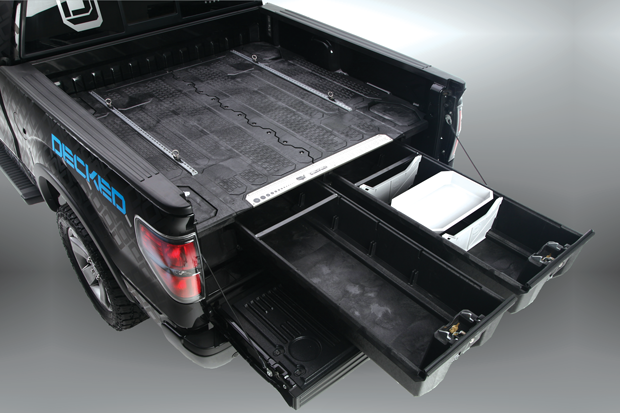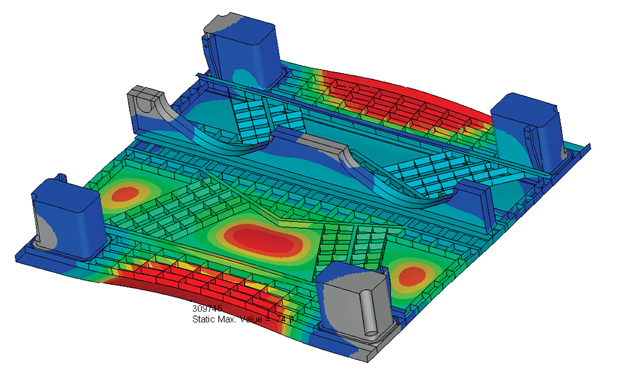
The DECKED truck bed storage system is designed to maximize the use of space with divided drawers and a deck that can support a 2000-lb. payload. Image courtesy of DECKED.
Latest News
November 2, 2015
 The DECKED truck bed storage system is designed to maximize the use of space with divided drawers and a deck that can support a 2000-lb. payload. Image courtesy of DECKED.
The DECKED truck bed storage system is designed to maximize the use of space with divided drawers and a deck that can support a 2000-lb. payload. Image courtesy of DECKED.Unless your last name is da Vinci, it’s unusual for an engineer to sign his work. That’s especially true when the engineers are from a service provider hired to help develop a product. “Customers typically like to keep us a secret,” says Tim Smith, vice president of Technical Operations at Altair ProductDesign. That wasn’t the case when the company was hired by Jake Peters, the general manager of DECKED, to help develop a truck bed storage system for the startup company.
“If you look at the bottom of the drawer in the storage system, they actually had the signatures of the people from Altair who worked on the product and the Altair logo,” says Cliff Boggs, vice president of Business Development for Altair ProductDesign.
“It was very refreshing to have a customer acknowledge us in such a permanent way by having that molded into the bottom of the drawer,” Smith says.
The story of how the DECKED truck bed storage system went to market began when Peters approached Altair ProductDesign, a division of Altair that provides product development, industrial design, workflow automation and staffing services.
The storage system was intended to “productize plywood,” Peters says, referring to the plywood storage boxes he and his partners saw in pickup truck beds around the ski resorts near Ketchum, ID, where the company is based.
Meeting Many Requirements
By the time they connected with Altair ProductDesign, the DECKED team had done its homework. They knew what the market would demand in terms of size, functionality and price. They also wanted their product to have a high-quality, custom feel that would appeal to customers who loved the outdoors and be rugged enough for customers in the construction trades.
The initial CAD design DECKED brought in failed validation. It was too heavy and would cost too much. Plus, DECKED didn’t know whether it would meet their payload requirements.
 Simulation of the original design show potential areas for cracking, which were engineered out in the revised design. Image courtesy of Altair ProductDesign.
Simulation of the original design show potential areas for cracking, which were engineered out in the revised design. Image courtesy of Altair ProductDesign.Altair ProductDesign engineers started anew on the design so they could begin the process using the HyperWorks suite of optimization and simulation software from its parent company. The price point and weight requirements dictated a molded plastic product. Peters also wanted to be able to sell the product online and ship it according to certain dimensions and weight limitations. The DECKED truck bed system also had to fit the beds of many sizes of pickup trucks from different manufacturers.
Peters initially wanted to be able to accommodate both full- and mid-sized trucks with 5.5-, 6- and 8-ft. bed lengths. To accommodate beds of different widths, the initial plan was to divide the DECKED storage system not down the middle, but in a 60/40 split for full-sized beds, which would allow two of the 40% split sections to be used in mid-sized truck beds.
“It became clear we were going to be suboptimal in performance because we were trying to accommodate too many truck bed permutations — 26 in all — with one design,” Smith says.
It was the 60/40 split, to accommodate the mid-size trucks, that was causing issues, Boggs said. Additionally, the 8-ft. bed length variant would increase tooling complexity. Given the fact that 8-ft. bed pickup trucks are only 3-5% of the full size truck market, DECKED decided to focus on 5.5- and 6.5-ft. beds, and abandon the mid-size truck bed permutations. That decision allowed Altair ProductDesign to split the deck in half in a patented design that uses just four tooling setups for 19 design variants.
“To keep the part count as low as possible, we came up with the idea to make the deck on the left the same as the one on the right, just turned 180°,” says Smith. Just two different decking designs were needed to accommodate all of the different truck bed sizes. “The center line is interleaved in such a way that the same tooling can be used without modifications, plus it made it possible to meet DECKED’s shipping requirements.”
Optimization Meets Manufacturing
Altair’s simulations showed a molded plastic deck alone would not be able to meet DECKED’s 2,000-lb. payload requirements. It would be prone to cracking when driven over bumpy roads. The answer was to reinforce it with steel. Altair ProductDesign used HyperWorks OptiStruct simulation and optimization software to help place the steel members optimally.
“The steel members were going off on many different angles because the topology optimization said that was the best location for these pieces given the load you want,” Smith says. “However, we engaged the molder very early in the process and they said flat out: ‘We’re not going to mold that part.’”
The molder knew the difference in thermal expansion of the steel and high-density polyethylene (HDPE) would lead to an uneven cooling rate longitudinally vs. transversely, so any steel member on an angle would cause the HPDE to crack. The molder was experienced with orthogonal design, and was reluctant to take on the spider web-like optimized design.
“They essentially had zero confidence they could mold it, so they wouldn’t sign up for it,” Smith said. “We had to rethink it.”
In the end, the engineers went with an orthogonal arrangement of the steel supports, but still used Altair OptiStruct to help guide their decisions.
“There were hiccups, but we figured them out,” Peters says. “They used software to figure out the optimal design and then used their own judgment to determine what’s optimal and [can be] manufactured. That’s how we got the design we did.”
That design helped launch DECKED and it won the prestigious SEMA Award for Best New Van/Pickup/SUV Product for 2014 during the SEMA Show in Las Vegas. The automotive show features thousands of new automotive parts, tools and components each year — though the DECKED truck bed storage system was probably the only one signed by the engineers who were instrumental in bringing it to market.
Design Requirements and Solutions | ||
2,000-lb. deck load | Using molded plastic alone was not strong enough. | Simulation revealed initial design would crack when driven over potholes under load; steel supports were added. |
Manufacturability | Reworking design of steel support structure so molders could accommodate it. | |
250-lb. drawer load | Prototyping showed sliders not adequate easy drawer pulling. | Sealed bearing wheels were used. Requirement dropped to 200 lbs. |
Shipped by less-than-truckload (LTL) freight | Fitting everything in a compact, dense carton. | Addressing shipping requirements as part of the up-front design process. |
Price point | Ensuring DECKED could be sold for under $1,000. | Keeping part count low and using the same parts for many versions. |
Easy attachment to truck bed | A no-drill design that would not require consumers to drill holes in their truck beds. | J-hooks and brackets designed to use the different tie down systems built into various pickup truck beds. |
Durability, custom look and feel | Prototyping showed standard, commercial drawer latches did not provide desired look and feel. | Altair ProductDesign created a custom latch to provide the desired consumer experience. |
Fit 5.5-, 6- and 8-ft. variants of mid- and full-sized pickup trucks from major OEMs manufactured since late ’90s | Getting specific CAD data of truck beds. Balancing costs to manufacture different variations. | OEMs provided CAD data, or pickup truck beds were 3D scanned; abandoned mid-sized and 8-ft. bed length variants. |
More Info
Subscribe to our FREE magazine, FREE email newsletters or both!
Latest News
About the Author
Jamie Gooch is the former editorial director of Digital Engineering.
Follow DE





